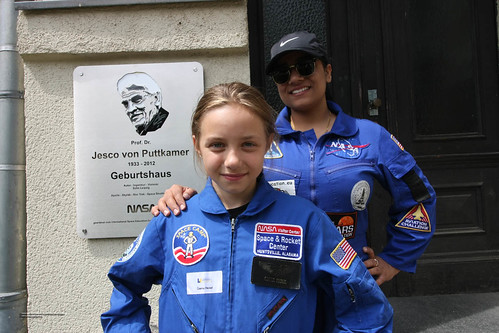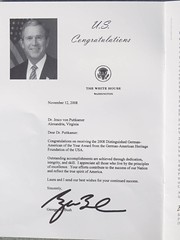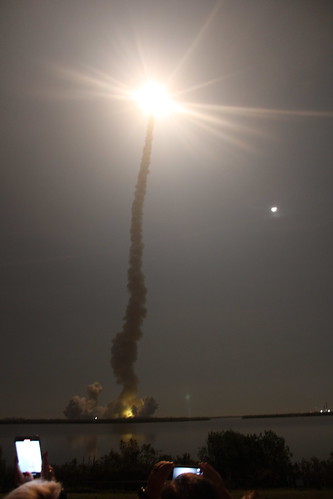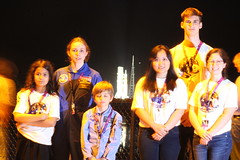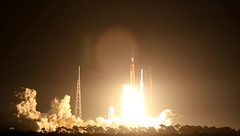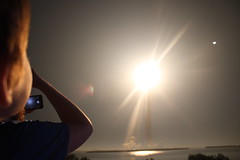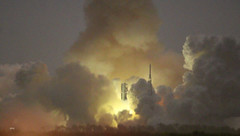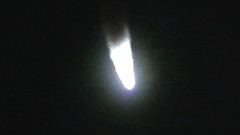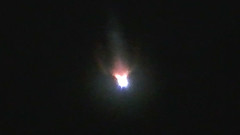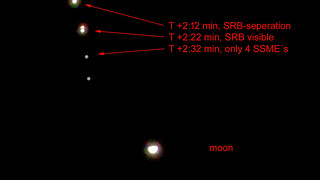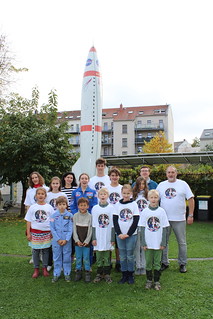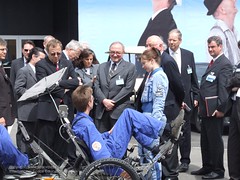| Weltreisen - 2023-2024 Rovernauts on Tour |
Blog | Fotogallery | Videochannel | Instagram | Facebook
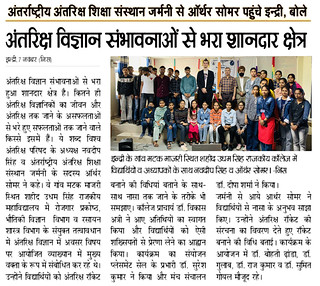 (Leipzig/Kurukshetra, 8.11.2023) Arthur Sommer (18) has now been active in India as an ambassador for the International Space Education Institute for 4 weeks. During this time he has covered more than 6,000 km on the subcontinent, traveled by train from north to south India and back for almost a week and attended over 30 events, trade fairs, scientific institutions and lectures.
(Leipzig/Kurukshetra, 8.11.2023) Arthur Sommer (18) has now been active in India as an ambassador for the International Space Education Institute for 4 weeks. During this time he has covered more than 6,000 km on the subcontinent, traveled by train from north to south India and back for almost a week and attended over 30 events, trade fairs, scientific institutions and lectures.
Arthur speaks about his experiences with us and NASA in schools, universities, conferences, symposiums and also at a cadet college of the Indian Army. The main focus is on the future in space, jobs and career opportunities. He presents these together with his own experiences from the launch of NASA's moon rocket ARTEMIS 1. He explains the individual phases of a launch and flight to the moon using a self-built model (1:87) of the SLS moon rocket. The young and mature audience is always enthusiastic. An overwiev in Fotos.
At many appearances he is supported by 16-year-old Cosma Heckel, who is then connected via video conference.
The first four weeks seemed much longer to Arthur, "because you experience so much in a short time here." He receives support from his mentor and teacher Navdeep Singh from the World Space Council India. The International Space Education Institute has built up this partnership over the years and supports the current transformation of over 30 countries into space nations with human capital through world trips for schoolchildren and students.
Arthur is also a member of the International Space Education Institute's 2024 NASA Human Exploration Rover Challenge accepted team called the Rovernauts. This team has a successful history of 16 years as the first international participant with 3 world championship titles and 44 lunar car-like vehicles in various variations.
As an ambassador for the NASA Artemis Generation, Arthur supports the agency's efforts to promote more science among young people under the name "STEM Engagement".
The world tour, a social year for graduating students, is available to members of the International Space Education Institute to gain global life experiences. This not only creates unforgettable experiences for life, but above all builds bridges across supposed boundaries and gives other students a unifying career vision for the future.
translation of the pressarticle from the top:
Arthur Sommer from International Space Education Institute, Germany reached Indri
Space science is a fantastic field full of possibilities.
Indri, 7 November (Nis) Space science is a wonderful field full of possibilities. It contains the lives of many astronauts and their stories of going to space, ranging from failures to successes.
These words were said by Navdeep Singh, President of the World Space Council and Arthur Sommer, member of the International Space Education Institute, Germany. He was addressing as the keynote speaker in a lecture organized on the topic of opportunities in space science under the joint aegis of Employment Cell, Physics Department and Chemistry Department at Shaheed Udham Singh Government College located in village Matak Majri.
PICTURE: He taught students about space rocket Navdeep Singh and Arthur Sommer with students and teachers at Shaheed Udham Singh Government College located in Matak Majri village of Indri.
Along with telling the methods of making it, also explained the ways to reach NASA. College Principal Dr. Vikas Attri welcomed the guests and called upon the students to take inspiration from such personalities.Dr. Suresh Kumar, in-charge of Placement Cell, coordinated the program and conducted the stage. Dr. Deepa Sharma did it.
Arthur Sommer, who came from Germany, shared his NASA experiences with the students. He gave details of the structure of the space rocket and explained the method of making the rocket.
Dr. Bohti Dhanda, Dr. Gulab, Dr. Raj Kumar and Dr. Sumit Goyal were present in organizing the program.
Cosma get accreditation as vocational-training ambassador!
The kits, which were laser-cut at the HOLL metalworking company, can now be ordered by any school for learning motor skills at the Leipzig Chamber of Crafts. The fully assembled, creatively designed and upgraded models with 3D-Print and an electric circuit will then be awarded prizes by Cosma and a jury of experts. Prizes and an invitation to the next NASA Rover Challenge in the USA will be awarded. On November 13th the Chamber of Crafts in Leipzig will present Cosmas educational set nationalwide.
(Leipzig 1933, NASA 1962-2012) Happy Birthday Prof. Dr. Jesco von Puttkamer today: 22.9.2022, Leipzig /Huntsville AL /Alexandria VA, International Space Education Institute e.V. On Friday, September 22, 2023, the German-American NASA scientist born at Salomonstr. 25 in Leipzig would celebrate his 90th birthday. His father worked as an editor at the Reclam publishing house and emigrated to Switzerland with his young family after the seizure of power in 1933. After the war, 12-year-old Jesco moved to his grandmother in Bavaria and attended school there. He often spoke of how the starlit Bavarian nights were his inspiration for space. He completed his mechanical engineering studies in Aachen in 1962. He financed his studies as an author of sci-fi paperback novels such as "Galaxis Ahoy" and "The Timemanuskript". After receiving a telegram from America: "Don't go into business, come to Huntsville, we're going to the moon, stop," the young engineer emigrated and worked on the Apollo program. His responsibilities included lunar gravitational anomalies and studies on the reusability of Saturn V stages, from which the space shuttle fleet emerged. His commitment to the Commercial Orbital Transportation Systems (COTS) program comes to impressive heights with SpaceX and other competitors this decade. Never putting aside his pen as an author, von Puttkamer wrote countless non-fiction and technical books on spaceflight as head of the Strategic Planning Division beginning in the 1970s. He also remained loyal to science fiction, advising Gene Roddenberry and Star Trek as a NASA representative and enlisting African-American Nichelle Nichols (known as Lt. Uhura) as an ambassador for NASA youngsters of the 1970s. His family's Slavic roots allowed him a conciliatory mentality with the scientists of the then-Soviet Union in the Apollo-Soyuz program, which, thanks in part to von Puttkamer's driving force after perestroika, resulted in various MIR missions with space shuttle flights and ultimately the construction of the International Space Station (ISS). Von Puttkamer held the post of NASA director for the ISS at Washington headquarters from 1998 until his death in 2012. Despite the Russian war of aggression, the ISS remains to this day a multinational peace ambassador for humanity in space and a guarantor of scientific cooperation. The engineer received various honorary doctorates and professorships for his tireless international work with students, which today already includes several generations of space scientists. In 2005, Prof. Dr. von Puttkamer decided to found a school for the early promotion of young space engineers together with citizens of Leipzig as a support association. At the turn of the millennium, he selected the then young Leipzig couple Yvonne and Ralf Heckel as personal aspirants for this development work. This school has achieved impressive results to date, producing numerous international space scientists, engineers and even aspiring female astronauts. Today, the school bears his name and comprises a small climate and science campus of 2000 m² in the east of Leipzig, not far from the house where he was born. Von Puttkamer received numerous awards. Above all, 2 outstanding honors should be mentioned here. In 2008 von Puttkamer received the title "Distinguished German American" with congratulations from the 43rd US President and NASA. In the same year the Jet Propulsion Laboratory dedicated a newly discovered asteroid between Mars and Jupiter, the "266752 Vonputtkamer". In 2007, von Puttkamer and his Leipzig school opened the gates for the first time for non-U.S. citizens to participate in NASA junior competitions at the NASA Moonbuggy Race (later NASA Roverchallenge). From this more than 100 teams grew up until today and already 3 world championship titles went to Leipzig.
Puttkamer was a visionary who saw the future as a body in front of him and could explain it in an understandable way. Each of his lectures between Moscow and California was an experience. It is as if this future built by him would bow deeply in these weeks, because: 1. valuable hand drawings and manuscripts in poster format from the Apollo period were recently found in the attic of his former home in Huntsville - they will be shown in Leipzig on his birthday. 2. the ISS shows itself on the evening of his birthday over the native city Leipzig at 20 o'clock on 90 degrees over Leipzig with -4,2 Mag particularly bright and close. 3. asteriod 266752 Vonputtkamer is currently in an unprecedented opposition to Earth and could actually be photographed by the institute's own self-built observatory 7 days ago at a distance of 150 million km (distance Earth-Sun) despite its small size and light faintness of -20 mag. It is currently found to the west of Jupiter between Aries and Pisces (the photos will be presented on Sept 22, 2023 for the birthday). 4. NASA and DLR sealed the return to the Moon last week by joining the Artemis program. 5. the first European young talents who were allowed to accompany an Artemis launch as VIP visitors are from Leipzig. They are 3 students aged between 8-18 years. 6. the COTS program of the NASA experienced a momentum of its own, so that now to the birthday the largest ever built moon rocket stands ready for takeoff on the test launch site in Boca Chica Texas. It is Elon Musk's Starship and a visualization of Puttkamer's vision. 7. the management of the Jesco von Puttkamer School already accompanied the first launch of the Starship on April 20, 2023 and is now opening educational tours to subsequent launches. 8. all over the world former "Puttkamer students" are involved in space missions and moon missions. This ranges from India to Leipzig to California. Since 2018, the Jesco von Puttkamer School also has a branch in India. A delegation from India is currently visiting Leipzig. Prof. Dr. Jesco von Puttkamer was the NASA face on German TV for over 50 years. His "children" now dominate social media with educational partners in over 30 countries, driving our future forward. He himself was never in space, but described himself as a "desk astronaut" and in his last book described the "millennium project Mars" and the landing of man on it. Today, he is commemorated by a plaque at the house where he was born in Leipzig and a plaque at his home in Huntsville, Alabama. Vor allem aber lebt im steten Raumfahrt-Nachwuchs aus der Leipziger Schule mit seinem Namen sein Lebenswerk fort. Für diesen 90. Geburtstag wurde in diesem Jahr beträchtlich in die Schule investiert in Hauptgebäude, Außenbereich und Werkstätten. Machen Sie sich selbst ein Bild. Those interested in lectures, talks, reminiscences and, above all, the future are very welcome. The program on 22.9.2023: The program afterwards: Contact: Contact person: Registration for the birthday party is required via WhatsApp. Admission is free, but birthday gifts are expected in the spirit of the professor after his words: "This youth must be actively supported. This is our debt to bring!" Birthday gifts please to the donation account: This e-mail address is being protected from spambots. You need JavaScript enabled to view it or in the following currencies in the next months and years to continue Puttkamers life's work: - time - commitment - ideas - and also money
The brightest night of my life - the start of the Artemis 1 11/17/2022 by Ralf Heckel Fotos Cosmas blog Rovernauts Launchreports Raumfahrt Concret Werner-Heisenberg-School
2 buses in black pull up. They are the VIP buses. They were prepared especially for this day. One has the Artemis logo on it, the other has the rocket printed on it. We are the only ones who dare to get in front of these buses today and take extensive photos. One of them appears the day after on the front page of the Leipzig Times. A better team photo could not be taken in the dark of that night. I've tried a lot, even with a manual wrist-held portable flash, long exposure bursts, and a number of lenses. Nothing came into focus because either someone walked through the picture or Jesco yawned. Bill Ingalls was missing here… In batches, the queue moves in the direction of the busses. It's a long line behind us now, reaching across the parking lot. We get the bus 346 and after an extensive counting of all guests with a report to the control center, the night begins. You can't see anything because the windows of the buses are darkened for the day trips in bright sunshine. The light is left on inside for this.
The SLS rocket is brightly lit on the horizon, quiet and slightly steaming. It is already filled. That's a good sign. Only 3% hydrogen is missing. The flame blazes again behind the launch tower, flaring off the boiling gases at a safe distance. In contrast to the first attempt, all visitors are now relaxed at this sight. A large screen shows the processes on site and moderators explain what is to come. Live broadcasts to all partners from Houston to Bremen show the size of the project. 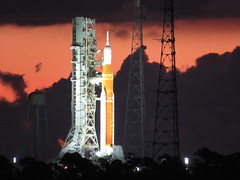  Then the shock, a leak! The RED TEAM drives with 2 cars directly in front of the steaming and fully fueled rocket. 3 people get out, 2 engineers and a security guard. The engines appear huge and underneath the three of them walk around in white clothes and helmets, climb into the launch tower. What I wouldn't give to be there now, under the steaming and hissing monster that 's about to fly to the moon. One spark and it's all gone. To this day I didn't know that people were allowed to get so close at such a moment. Apparently they are doing their job well. Then the fixed bolt reports a "GO" again. Breathe easy! Then the shock, a leak! The RED TEAM drives with 2 cars directly in front of the steaming and fully fueled rocket. 3 people get out, 2 engineers and a security guard. The engines appear huge and underneath the three of them walk around in white clothes and helmets, climb into the launch tower. What I wouldn't give to be there now, under the steaming and hissing monster that 's about to fly to the moon. One spark and it's all gone. To this day I didn't know that people were allowed to get so close at such a moment. Apparently they are doing their job well. Then the fixed bolt reports a "GO" again. Breathe easy!
During the last half hour, the countdown remains at -10 minutes. Now the flight director queries all the individual departments and demands a GO. Any answer that is a GO will be applauded and cheered by the audience in our grandstand. One place didn't seem sure about. There was no answer 3 times, until finally the GO could be clearly heard. Big cheers. The restlessness in the audience increases with the excitement. Everyone here is now aware that they are witnessing a new story. They will later be divided into a before and an after. Many do not yet know what is really behind this first start, which tests are now to follow and what they will influence in the future. Only those in the know here know that this rocket will one day put together an entire space station in lunar orbit and thus form the gateway for permanent bases on the moon. T -15 seconds, "Free for ELS" Now there's no turning back! A shock wave shakes the ground and makes the water rough in Banana Creek. With a great flash, huge blazing white flames erupt from the two boosters, giving instant boost. Several retaining bolts between the rocket and the launch pad tear through and the rocket lifts off. "We have a liftoff !”
CAM1 CAM2 CAM3 CAM4 CAM5 CAM6 CAM7 CAM8 CAM9 But otherwise everything is still calm. Slowly, the colossus rises with the weight of a 2,800-ton battleship. That's a third of the weight of the Eiffel Tower. The light is getting brighter and blinding. White clouds are spreading at high speed on the right and left of the ground. More than a million liters of cooling water are currently evaporating here. As the rocket exits the launch tower, they swing the main engines away from it. When leaving the tower, the course maneuver begins. But there is no sign of any of this. Onlookers yelled and screamed incessantly, some holding their phones in front of their faces as the rocket picked up speed. It dazzles like a sun and others shield their eyes with their hands.
The rocket is now very high. It illuminates the whole of Cape Canaveral as bright as day. You has nearly to close your eyes. The day after, residents of Cocoa , 30 km away, tell me that they have never seen such a bright launch. Their window panes had never shook in such a way.
In the meantime, from our position, the Artemis seems to have reached the top. It hangs like a lamp on a huge slender stand of smoke illuminating the entire region. Even the damp air grows light, lighter than the black column of smoke beneath it. But the light grows pale and casts long, sharp shadows. The thunder dies down. The rocket is now just a flickering short dash, seemingly arcing downward, heading straight for the crescent moon lingering below. He is lying on his stomach and seems to want to catch her like an open-topped bowl.
Our students still can't believe it. Sakurako has her hands on her face and looks through her spread fingers as if she wants to stay in the old days for a while. "Wow", " Amazing ", "Awesome" are the words I hear more and more now. The lighting is switched on again.
There will also be a new young talent competition in Europe, which is politically more independent, more future-oriented and multinationally more balanced than anything we have been able to get to know and help shape so far. Team Attempt 1-2 (September 2022): Team Launch: special thanks to: thanks to our sponsors: Weblinks: Press: This educational travel and excursion was managed by International Space Education Institute Leipzig/Germany.
From “Return to Flight” to “Return to the Moon”
But it all goes back 20 years. Exactly 20 years ago in the autumn, Professor Dr. von Puttkamer said: "I'm in Leipzig right now and if you want, we can meet up." Freshly in love with Yvonne, we came to the Hotel Fürstenhof and listened to what the professor had to say. “We will soon be expanding the ISS and for that we need young people, because one day we want to go back to the moon. If you do well and stick to that goal, I promise you'll be there with a new generation of space explorers.” At the time, that sounded too fantastic to be true. Nevertheless, it should take 20 years until this promise should come true in return for solid youth work around the world. Step by step we implemented the professor's ideas until he opened doors at NASA in return. The first launch window opened three years later with an invitation to the shuttle launch at Cape Canaveral. "Return to Flight" was the name of the flight of the Discovery, which was the first space shuttle to resume flight operations after the Columbia disaster. Pilot Eileen Collins heralded the space age of women. Since then, the ISS space station has been expanded and 10 years ago the last of the proud swans flew. We saw 3 launches and one landing, mostly with students. We provided the first international team at the NASA Rover Challenge, won prizes and inspired thousands of students with complex trips around the world, from which hundreds of teams emerged. Everything always with the words of the professor: "You have to be trail blazers and take responsibility for what follows!" That's how it happened until the 50th anniversary of Apollo 11, with the 3rd world champion title. Our strongest participants are the girls. They sit in the front of the pilot's seat, not only in the Roverchallenge. But the female astronauts moved on board the ISS, the first woman on the moon is being discussed and “Helga”, an astronaut dummy from Germany, is now sitting in the Orion capsule. Astronaut Pamela Melroy , with whom we shared the same hotel in 2005, is now NASA's deputy administrator. That's why today more girls than boys are with me at Banana Creek, watching the rocket launch and listening to the instructions of the first flight director in history, Ms. Charlie Blackwell-Thompson.
These are all results that you don't have to hide from, no matter how rocky this path was and no matter how many setbacks there were. They are the result of solid work that must not be messed with. And as with all successful endeavors, ours also have their envious people. But more on that later. I see this as a distinguishing feature and award from people who capitulate to the need to "take the difficult path". Our former host from 2005, then-astronaut and administrator of US manned space travel, Bill Ready, is still our advisor behind the scenes today. But now our small group of four is sitting in the Beachside Hotel in Cocoa Beach and writing down the experiences of yesterday. I'm trying it too.
|




































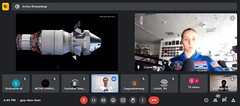
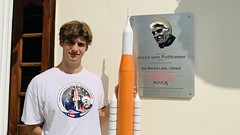
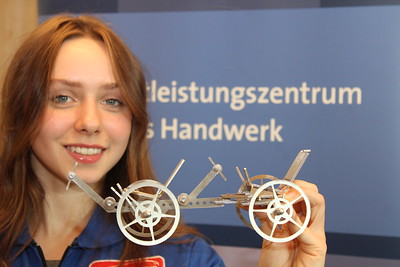

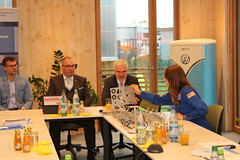
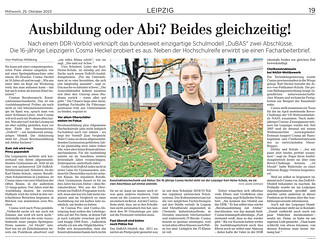 The occasion was today's appointment of Cosma as an ambassador for training in the craft, made by the President Mr. Matthias Forßbohm, the Chief Executive Mr. Volker Lux and the press officer Dr. Andrea Wolter, the Chamber of Crafts Leipzig. This happened during the press conference of the Chamber of Crafts for the publication of the economic figures and the start of a special program for career orientation in schools in which Cosma plays a leading role with her self-modified 1:10 models of the Moonbuggys.
The occasion was today's appointment of Cosma as an ambassador for training in the craft, made by the President Mr. Matthias Forßbohm, the Chief Executive Mr. Volker Lux and the press officer Dr. Andrea Wolter, the Chamber of Crafts Leipzig. This happened during the press conference of the Chamber of Crafts for the publication of the economic figures and the start of a special program for career orientation in schools in which Cosma plays a leading role with her self-modified 1:10 models of the Moonbuggys.






